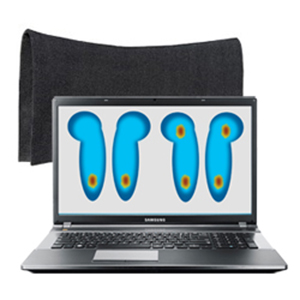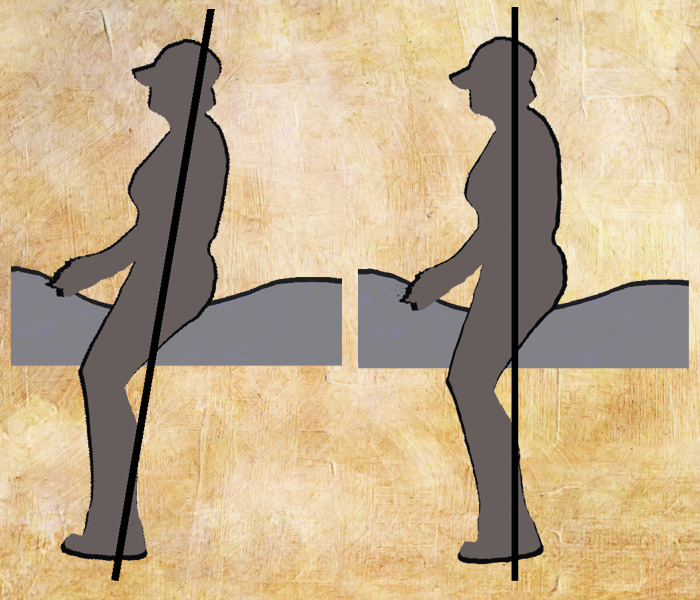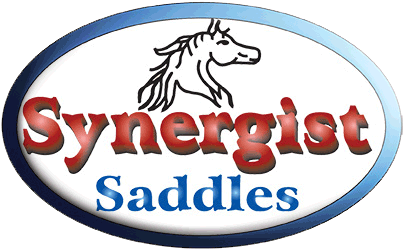Different pressure sensor pads for evaluating saddle fit have been on the market now for over ten years. Some are simply a pad filled with a dough that will leave an impression after riding your horse for a specified amount of time. The dough will squirt away from high pressure areas and be thick where there is little or no pressure.
Another type of high tech pad has pressure sensors spread over the pad and a computer receives the data and creates a visual representation of high and low pressure areas. With either of these systems the concept is simple but the data received can be very deceptive.
 My first experience was about 10 years ago with a sensor pad that was connected to a laptop. This could only check a standing horse. Newer sensor pads today now carry a mini computer to record data that is then uploaded to a actual computer for analysis.
My first experience was about 10 years ago with a sensor pad that was connected to a laptop. This could only check a standing horse. Newer sensor pads today now carry a mini computer to record data that is then uploaded to a actual computer for analysis.
We had a customer who had paid a saddle fitter to come out with their new equipment and evaluate her new saddle on her horse. She called us afterwards and said she had a problem. We arranged to meet with her and the fitter the next weekend.
The fitter had her tack up and sit in the saddle with the sensor pad underneath. The fitter then fired up the computer and we looked at the visual on the screen of the overall pressure on the horse’s back.
According to the fitter blue was low pressure, red was high and yellow was in between. She again had the rider sit in the saddle and I was able to see graphically what was going on under the saddle. There was an area of yellow turning to red under the tails of the bars in the back of the saddle. Being a self confessed nerd, I was initially very impressed with this new technology. I actually thought that this was going to change the way we were doing things. My mind was racing. I just had to have one!
I talked with the fitter and we both agreed that I needed to build the bottom of the tree up in the area ahead of the pressure so it would lift the saddle up relieving the pressure. I stripped down the saddle right there and then and made the adjustments and put the saddle back together. No improvement! What?
 Being the nerd I am I immediately went analytical. I had built up the tree ahead of the pressure why wasn’t the pressure gone? That’s when it hit me. I noticed the rider was sitting with legs forward and upper body leaning towards the back of the saddle. What we call ‘chair seat’. Since the computer was giving us real time data I simply asked the rider to bring here feet underneath her and helped her find a more balanced position with her upper body. The pressure disappeared immediately. Then I had the rider stand in her stirrups and lean forward like a jockey. Now the computer said the saddle didn’t fit in the front.
Being the nerd I am I immediately went analytical. I had built up the tree ahead of the pressure why wasn’t the pressure gone? That’s when it hit me. I noticed the rider was sitting with legs forward and upper body leaning towards the back of the saddle. What we call ‘chair seat’. Since the computer was giving us real time data I simply asked the rider to bring here feet underneath her and helped her find a more balanced position with her upper body. The pressure disappeared immediately. Then I had the rider stand in her stirrups and lean forward like a jockey. Now the computer said the saddle didn’t fit in the front.
Now I was intrigued. I had her move around a little bit more in the saddle, sometimes side to side, sometimes front to back. The readings kept changing every time she moved. So, the computer was giving us data that was more about the rider’s balance in the saddle than how the saddle was actually fitting. I asked the fitter how do we account for the rider’s balance in this scenario? The fitter was totally stumped. He had been using this system already for a year and never figured out that the rider’s balance was skewing the results.
That was on a standing horse. Newer systems now collect data on the moving horse where rider balance has even more impact loading and unloading weight in different areas of the saddle based on where their balance is at any given moment. After talking with a handful of saddle fitters since then that are using these systems I have yet to receive a satisfactory answer on how you take the rider’s balance out of the data and separate if from the actual saddle fit data. It seems you can’t.
So is this wasted technology? Absolutely not. Where this technology is very useful is when the same rider on the same horse tries out 3 or 4 saddles and then compares the results. This shows very clearly which saddle works the best with that particular horse/rider combination regardless of whether the rider is well balanced or not.
My dad figured out years ago that when you evaluate saddle fit you have to take into account the rider, the horse and the saddle that links them together. The saddle is just a tool and like all tools to get the best results you have to use the tool properly. When applied to riding this means a saddle works best when your weight sits in the center of the saddle form side to side and front to back. Yes, a perfectly fit saddle can sore a horse because of poor rider balance. Ever seen white hairs on a colored horse only on one side of the wither? 9 times out of 10 that’s a rider that sits heavy to one side.
So keep in mind that while these systems seem to be giving relevant saddle fit information, that very information can be skewed very easily by how the rider sits a saddle. However, when used to evaluate different saddles with a same horse/rider combination, the information can be very useful. Just like Paul Harvey used to say “Now you’ve know the rest of the story. Good Day!”


Comments 3
Thanks for sharing this experience, I’m going to share it to Prince Albert Performance Horse Development -=PHD – it is another nugget of knowledge – perhaps one of the ways to balance the rider – is the balance the saddle to the rider in the same way a saddle is balanced to a horse. Delle
IN this article is mentioned that there are “high” tech sensor pads. I want to know more abouth these. Can you help me with adresses?
Author
Here are a couple of websites you can visit. Also if you Google ‘equine pressure sensor pads’ there are probably more.
Thanks, Dave
http://www.sensorprod.com/dynamic/saddle-pressure-mapping.php
http://dynamicsaddlefitting.com/the-system/